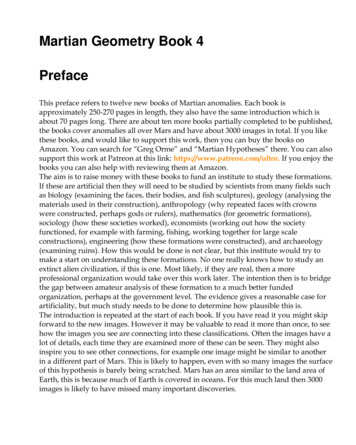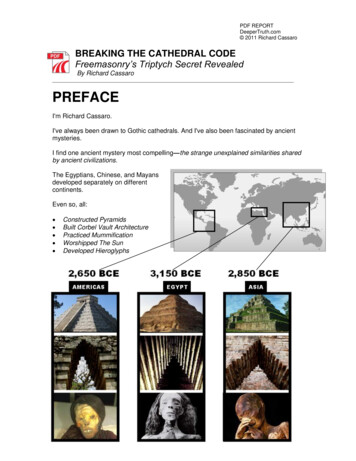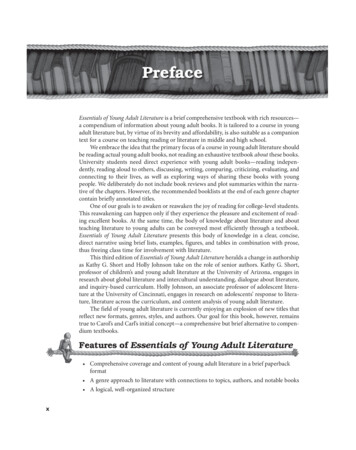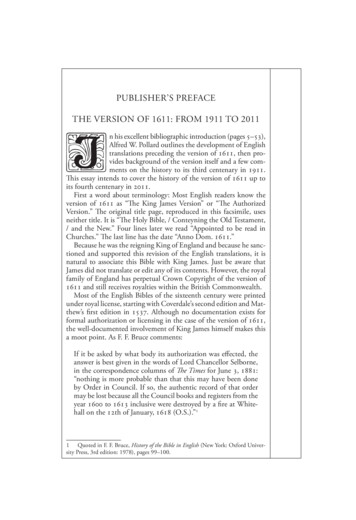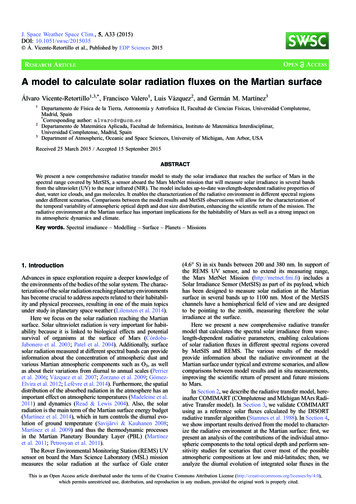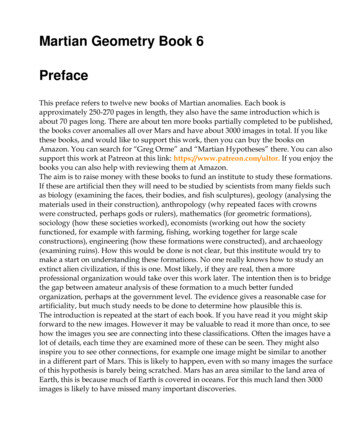
Transcription
Martian Geometry Book 6PrefaceThis preface refers to twelve new books of Martian anomalies. Each book isapproximately 250-270 pages in length, they also have the same introduction which isabout 70 pages long. There are about ten more books partially completed to be published,the books cover anomalies all over Mars and have about 3000 images in total. If you likethese books, and would like to support this work, then you can buy the books onAmazon. You can search for “Greg Orme” and “Martian Hypotheses” there. You can alsosupport this work at Patreon at this link: https://www.patreon.com/ultor. If you enjoy thebooks you can also help with reviewing them at Amazon.The aim is to raise money with these books to fund an institute to study these formations.If these are artificial then they will need to be studied by scientists from many fields suchas biology (examining the faces, their bodies, and fish sculptures), geology (analysing thematerials used in their construction), anthropology (why repeated faces with crownswere constructed, perhaps gods or rulers), mathematics (for geometric formations),sociology (how these societies worked), economists (working out how the societyfunctioned, for example with farming, fishing, working together for large scaleconstructions), engineering (how these formations were constructed), and archaeology(examining ruins). How this would be done is not clear, but this institute would try tomake a start on understanding these formations. No one really knows how to study anextinct alien civilization, if this is one. Most likely, if they are real, then a moreprofessional organization would take over this work later. The intention then is to bridgethe gap between amateur analysis of these formation to a much better fundedorganization, perhaps at the government level. The evidence gives a reasonable case forartificiality, but much study needs to be done to determine how plausible this is.The introduction is repeated at the start of each book. If you have read it you might skipforward to the new images. However it may be valuable to read it more than once, to seehow the images you see are connecting into these classifications. Often the images have alot of details, each time they are examined more of these can be seen. They might alsoinspire you to see other connections, for example one image might be similar to anotherin a different part of Mars. This is likely to happen, even with so many images the surfaceof this hypothesis is barely being scratched. Mars has an area similar to the land area ofEarth, this is because much of Earth is covered in oceans. For this much land then 3000images is likely to have missed many important discoveries.
You can also use the indexes in each book, they refer to many similar formationsthroughout them. For example, if you are looking at hypothetical road formations thenroads in many different areas can be found in the indexes. It would be possible then toquickly see all the different kinds of hypothetical roads in all 10 books. The idea behindthe introduction is to give an outline to the global hypothesis, how these differentformations connect together into a hypothetical Martian civilization. It’s important thento get an intuition of how these formations connect together globally.Some areas for example might have hypothetical roads for transport, other might havehypothetical tubes like a covered road. Different terrain, available materials, and climatemight have led to one being used over the other. It may be as Mars cooled it becamenecessary to travel under cover because of the cold. Another possibility is predators ormeteors made traveling on roads too dangerous. Also there are many hypothetical damformations, but the construction techniques vary between areas. Some are formed withdam walls attached to the crater, when they break some show a cavity under them andothers do not. This would indicate the dam wall was dug into this cavity to keep it fromsliding down the crater wall. In other areas this was not necessary, it may be that therethe crater wall was harder rock which the dam wall could be cemented to. Some showcolumns and layers in them but others have evenly spaced vertical grooves on the damwalls. Some dams are excavated out of the crater wall or the material at the bottom of thecrater, these may depend on the rock type in the crater. For example, if the crater wall istoo easily broken then an excavated dam might have been the best engineering solution.Some areas have hollow hills, these are where a hollow habitat may have been built on anexisting hill or the whole hill was constructed. In some areas these have layers similar to aCobler Dome, this is where bricks form the dome in decreasing circles as the dome isbuilt up. These are called amphitheatres as a friendly name, the first amphitheatreformation looked more like seating around an amphitheatre. Other hypotheticalbuildings have no layers in their roofs. This may have depended on the materialsavailable. Many appear to have a smooth skin like cement which has broken up in someparts of the roof, and is intact in others. In many areas this is more intact on the southernside, as the skin breaks off the softer inner parts of the roof appear to have eroded fasterand collapse. The one sided erosion may imply a prevailing wind, or as the oceans andair froze at the pole this created the erosion.There are also large areas of walls and room like shapes, these are hypothetical cities.Other areas connect these hollow hills together with tubes or roads as another kind ofhypothetical city. Still others seem to be made of tubes that connect together inintersections called a tube nexus. This may have been because of the climate further fromthe equator, for example tubes might have been used to travel through in colder areas.
The Martian Faces are mainly discussed in books 11 and 12, a reprint of published peerreviewed papers. These differ according to where they are. The Cydonia Face, Nefertiti,and King Face all fall on a great circle, this is hypothesized to have been an old equatorthat lines up with a known previous pole position west of Hellas Crater. The newlydiscovered Queen Face is in Cydonia but not near the old equator. If the faces were usedto mark latitudes and longitudes then the overall system remains obscure. For examplethere is a large hyperbola shown close to the old equator. Another is far from thisequator, but drawing a line from it to Nefertiti gives a right angle to this old equator.Joining these two hyperbolas and the King Face gives an Isosceles Triangle. Thehypothesis of these mapping system is highly speculative at this stage.Canals, lakes, and water channels also vary in different areas. West of Cydonia there is anextensive array of hypothetical canals, also east and west of Elysium Mons. Some of theseconnect to larger lakes which may be artificial. Some hypothetical dams have waterchannels to direct water into a dam, and to collect an overflow to another dam.There are also darker areas often bounded by walls or geometric shapes. These may havebeen farms, why they appear in some areas like around Cydonia and in Isidis remainsunanswered. Other areas contain hypothetical artefacts but no farm formations, so thesecreatures would have used a different way of collecting food.The idea of these books then is not just to prove artificiality, but to try to prove a globalhypothesis of how the whole civilization functioned. Once the evidence becomesplausible enough, and the shock wears off, this larger question is much more interesting.Each section is labelled with the title hypothesis to make clear these notions are beingproposed along with the evidence there. The sections all have many keywords connectingto the index. If you see a connection to a kind of formation then it is easy to find similarformations. In seeing the global hypothesis the different pieces of the puzzle are morelikely to come together, for example the hypothesis of dams sounds less plausible if it isnot connected to the hypothesis of buildings and farms. Together they give the ideas ofhabitation, food, and water. The conclusions can be controversial. However there is somuch evidence it was better to put it all together into a more comprehensive hypothesis.Otherwise people are looking at isolated formations like faces without seeing the overallcontext in which they appear.Ecydhh2118
HypothesisA shows two tubes coming out of a hollow hill with a settled roof. B shows thisconnecting through a collapsed roof to another hollow hill at 4 o’clock. At 8 o’clock maybe another tube. Shows a collapsed segment of the hill at 1 o’clock and a second hollowhill at 5 o’clock.Ecydhh2118aHypothesisAn approximate parabola is shown.
Ecydhh2119HypothesisA, B, and C show a tube connecting two hollow hills. A at 8 o’clock shows where the roofhas collapsed. B shows how a hill surrounding a crater connects to this tube. C shows adark rectangular segment at 8 o’clock connecting to the tube and the main dome at 4o’clock.
Ecydt2120HypothesisA shows two tubes connected, B shows a tube expanding into a triangle beforeconnecting to a hollow hill surrounding a crater at D. C from 8 to 3 o’clock shows howthis tube connects to another crater, it forks into a second tube going into a hill from 10 to2 o’clock.
Ecydt2122aHypothesisA, B, and C show excavation dams cut into the crater floor.
Ecydt2122a2HypothesisTwo parabolas are shown.
Ecydt2122bHypothesisA shows an artificial looking bend in the side of the dam at 8 o’clock, two other dams at 4and 6 o’clock. B shows another dam with an overflow dam at 6 o’clock second leg.
Ecydt2122b2HypothesisThree parabolas are shown.
Ecydt2122cHypothesisA and B show how the dam wall is degrading, A at 8 o’clock is in good condition, at 5and 7 o’clock the cement edge of the dam wall has been undermined perhaps from wateroverflows in the past. B shows a double wall from 2 to 7 o’clock as if the central dam wallhas eroded away or fallen off. The wall may have been full of gravel with an inner andouter skin of cement, when the top breaks then the gravel would fall out leaving ahollow. At 7 and 8 o’clock first and second legs there is an undermining of the wall.
Ecydt2122c2HypothesisTwo parabolas are shown.
Ecydt2122dHypothesisA shows regular layers, perhaps how these formations are constructed. B at 8 o’clockshows these layers go deep into the rock to the crater wall. B at 6 o’clock shows thesmooth dam wall, at 4 o’clock the dam wall top is falling apart. C at 6 o’clock shows thedam is highly eroded as is the arch between B and C unlike at A. At C at 2 o’clock thedam wall also shows some layers.
Ecydt2122d2HypothesisA parabola is shown. C was probably also a parabola.
Ecydt2122eHypothesisA at 8 o’clock would also be a small parabola, at 5 o’clock is an inner and outer parabola.At 2 o’clock the dam wall is eroded but still shows a clear edge to it. B is also eroded, thismay be more from the material in the crater than flaws in the construction.
Ecydt2122e2HypothesisAn inner and outer parabola is shown.
Ecydt2122fHypothesisThis may be a collapsed tube, a dam, or canal, A appears to be dams. B shows this deepchannel and how the top of the wall is eroded here. C shows the wall has cracks in itperhaps eroding like B but less advanced. D at 6 o’clock shows the top of the wall isflattened, at 4 o’clock it may have pillars in it.
Ecydd2124HypothesisA, B, and C show excavation dams, this material may have been brought up from thebottom of the crater. Alternatively dunes and other loose material could have beenpushed into the crater, but this would show signs around the top of the crater.
Ecydd2124aHypothesisTwo parabolas are shown.
Ecydt2125HypothesisA and B show a wall or tube connecting a crater and a hollow hill. A shows a connectionto the crater at 8 o’clock and a connection to another altered crater at 5 o’clock. D at 11o’clock shows this connection to the hill, at 1 o’clock the hill is collapsing. C shows aconnecting tube approximately at right angles, this may go underground. E shows asmaller tube connecting to a crater.
Ecydt2125aHypothesisThe two tubes are quite straight, with an angle of 90 between them.
Ecydt2126HypothesisA and B show tubes between craters and hills. C shows another tube going to a crater. Dfrom 7 to 11 o’clock shows a thicker tube connecting to a crater, a smaller tube at 4 o’clockconnects to another crater. E and F show more tubes.
Ecydhh2127HypothesisA shows a wavy tube at 10 o’clock, at 4 o’clock is a wall or dam surrounding part of thehollow hill continuing down to B. C shows a collapsed segment of the hill, D shows acavity on the roof. E shows another collapsed segment at 8 o’clock, this continues up to 11o’clock. At 2 o’clock is a wall perhaps a pit dam.
Ecydhh2127aHypothesisThis shows a parabola forming part of the hollow hill. Also the lines show how straightparts of the formation are.
This next section shows formations in and near Isidis Crater.Ist2128HypothesisMany tubes are shown here connecting to craters. F shows two of these, it crosses a tubeat C going up to D.
Ist2128aHypothesisThis shows how straight some of the tubes are.
Ist2131HypothesisA shows a tube connecting craters, it goes up to B around a crater then over to C and Dinto a hill.
Ist2142HypothesisA and B show tubes connecting many hills. These continue up to C and then down to Dand E. 13 out of 14 hills are connected by tubes here.
Ishh2143HypothesisA shows a wavy tube as if it was broken by a flood or high winds. This connects to thehill at 2 o’clock, segments have collapsed such as at 4 o’clock. B shows other collapsedsegments of this hill at 8 and 10 o’clock. At 11 o’clock first leg there is a tube coming outof the hill, at the second leg there is a collapse in the roof. C shows another tube comingout of the hill.
Ist2200HypothesisA shows some straighter tubes, B at 1 o’clock shows how the tube has eroded into a seriesof arches or pillars. It connects to other tubes at 7, 8, and 11 o’clock. A triangle is shown at4 o’clock, probably a collapsed hollow hill. Some of the other hills in this area aretriangular, there may be an entrance at C at 10 o’clock. At 2 o’clock the tube has collapsedinto a much wider shape or this was another hollow hill. D shows a wavy tube, this hasan entrance between it and the tube at E or it rolled to become disconnected from it.
Ist2206HypothesisA shows tubes connecting craters or pit dams at 11 and 12 o’clock, also at 4 and 5 o’clock.At 2 o’clock these tubes connect together. At B at 10 o’clock there may be a small segmentof tube that has become disconnected. This continues on through another pit dam at 11o’clock into a hill at 1 o’clock then a second hill at 2 o’clock. C shows a straight tube froma crater to a hollow hill and beyond it.
Ist2206aHypothesisThis shows how straight some of the tubes are.
Martian Geometry Book 6 Preface This preface refers to twelve new books of Martian anomalies. Each book is approximately 250-270 pages in length, they also have the same int
